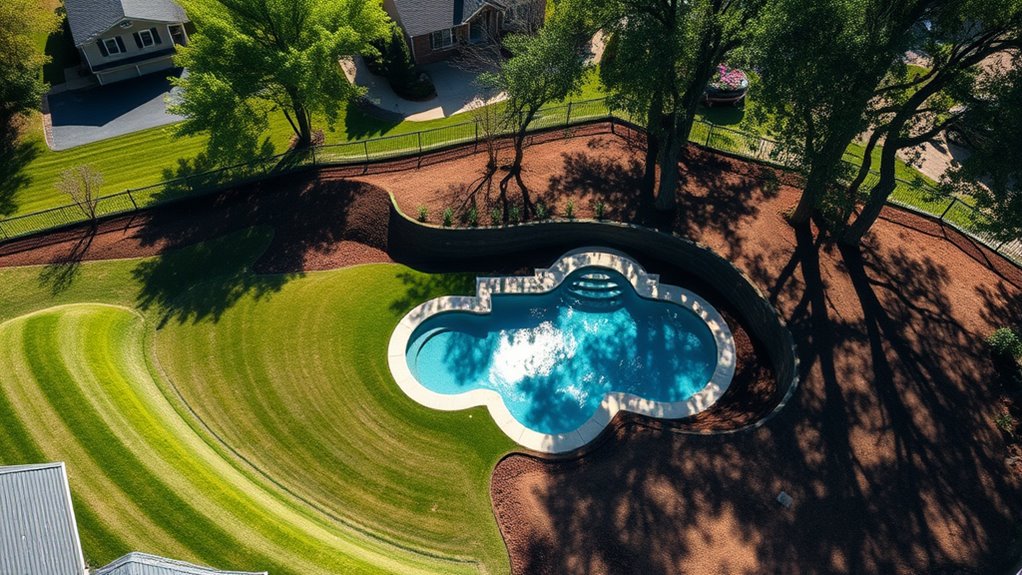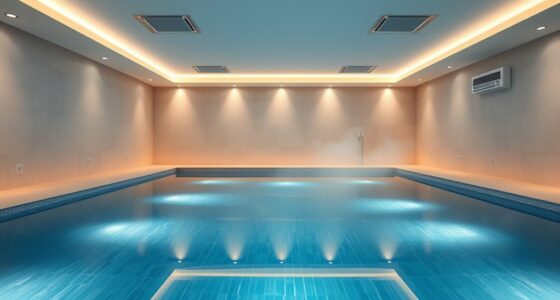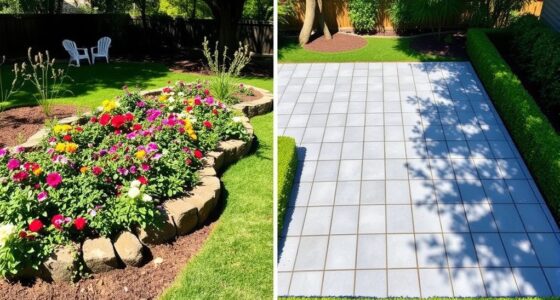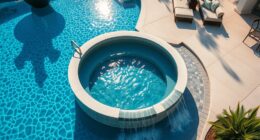Yes, you can still build a pool on a sloped lot with a high water table, but it requires careful planning. You’ll need to evaluate your land’s topography, soil type, and water level. Using specialized pool designs like infinity or terraced pools, along with proper drainage and waterproofing, can help manage the challenges. Working with experienced professionals ensures your pool stays safe and durable. Keep exploring to discover how to make your dream pool a reality.
Key Takeaways
- Specialized pool designs like infinity edges and terraced pools adapt well to sloped terrain, reducing excavation needs.
- High water tables require waterproofing, drainage systems, and deep footings to prevent flooding and foundation issues.
- Conduct thorough geotechnical and soil tests to determine soil stability and suitable construction methods.
- Proper site grading, waterproof barriers, and drainage planning are essential to manage water flow and prevent structural problems.
- Collaborate with experienced engineers and contractors to ensure compliance, stability, and long-term pool durability.
Assessing Your Land’s Topography and Soil Conditions
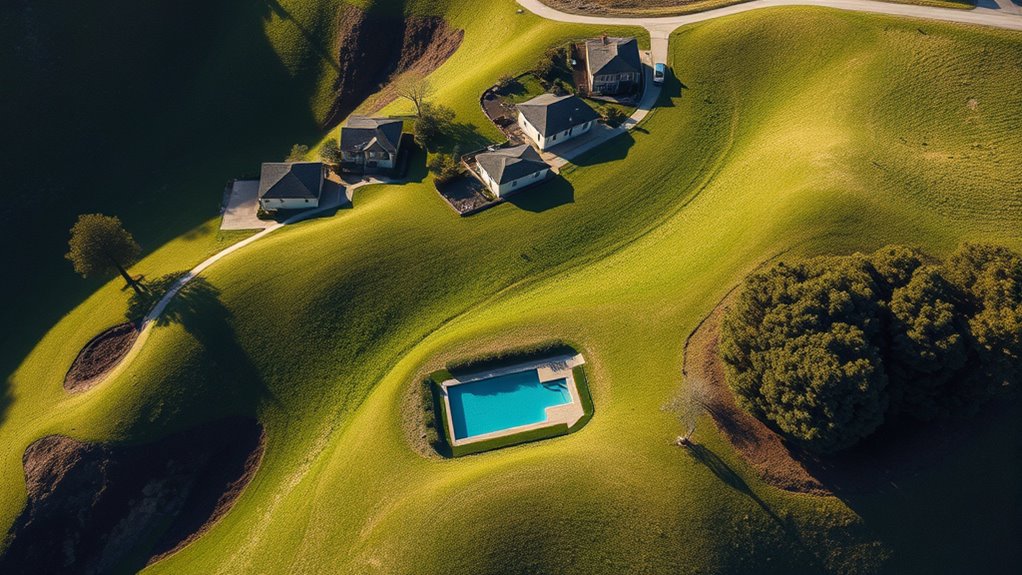
Before building a pool on sloped land or in areas with high water tables, you need to carefully evaluate your land’s topography and soil conditions. Start by examining the slope and contour of your property. Is it uneven or steep? This affects excavation and foundation stability. Next, assess soil types—clay, sandy, or loamy soils each behave differently under load. Conduct a soil test to determine drainage capacity and drainage issues. High water tables can cause flooding or poor foundation support. Knowing how deep the water table is will influence your construction plans. You might need specialized drainage solutions or soil stabilization. Additionally, understanding the bedroom design and how natural materials interact with moisture levels can help in planning for a durable and safe pool area. Taking these steps early helps you identify potential challenges and guarantees your project’s success before investing in construction.
Choosing the Right Pool Design for Challenging Terrain

When building a pool on challenging terrain, choosing the right design is essential to guarantee stability, safety, and aesthetic appeal. Your goal should be to select a design that adapts to the land’s slope and water table conditions. Consider these options:
- Infinity or Negative Edge Pools: These work well on sloped lots, creating a seamless visual transition and minimizing excavation.
- Terraced Pools: Built in levels, terraced pools follow natural terrain and reduce soil disturbance.
- In-ground with Reinforced Walls: Using retaining walls and reinforced structures helps stabilize the slope and prevents shifting or collapse.
Matching the pool type to your property’s topography guarantees durability and reduces costly modifications later. Consult with a professional to determine the best fit for your land’s specific challenges.
Groundwater Management and Drainage Strategies
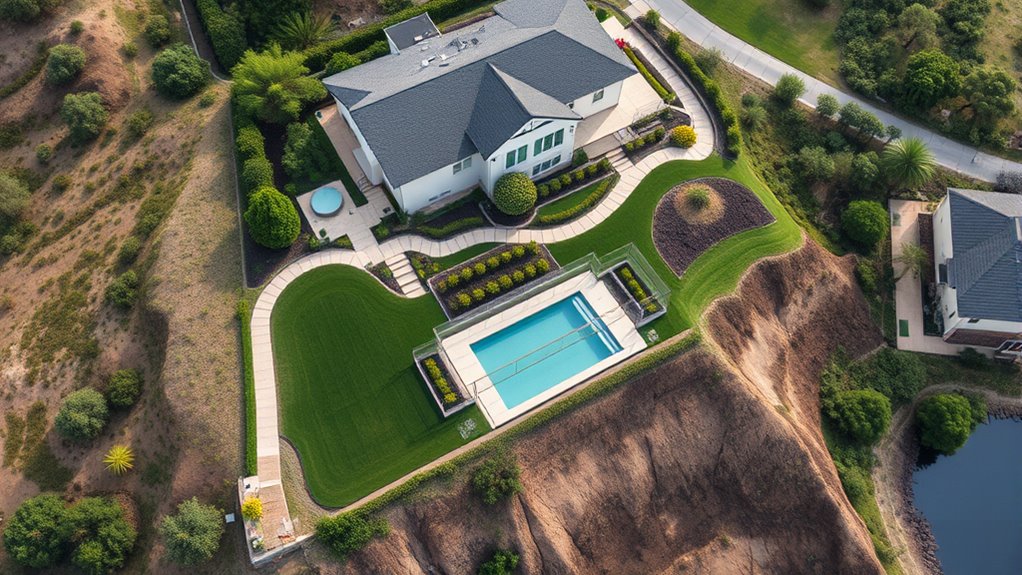
Managing groundwater levels is essential to prevent pool flooding and structural issues. You’ll need effective drainage solutions to redirect water away from the site and protect your investment. Don’t forget to check local permits and regulations to guarantee your plans stay compliant. Incorporating a total-cost clarity approach can help you choose the most effective drainage system within your budget.
Managing Groundwater Levels
Effective groundwater management is crucial to prevent flooding and ensure your pool remains stable on sloped land with high water tables. You need to control how groundwater interacts with your property by implementing strategic measures. Consider:
- Installing well points or sump pumps to lower water levels temporarily during construction or heavy rain.
- Using impermeable liners or barriers to limit water seepage into the pool area.
- Monitoring water table fluctuations regularly to adjust your management tactics proactively.
These strategies help prevent water pressure from destabilizing your pool’s foundation and reduce flood risks. Proper management also extends to maintaining proper grading and ensuring that groundwater doesn’t accumulate around your pool structure, which could lead to future issues. Staying vigilant and adaptable is key to successfully managing groundwater levels in challenging sites. Additionally, understanding groundwater management techniques can help you develop long-term solutions to mitigate ongoing water table challenges.
Effective Drainage Solutions
To guarantee your pool remains stable on sloped land with high water tables, implementing proper drainage solutions is essential. You should consider installing a thorough drainage system that directs excess water away from your pool area. French drains, which consist of perforated pipes surrounded by gravel, are effective for channeling groundwater underground. Additionally, sump pumps can help remove water that accumulates beneath the pool’s foundation, preventing soil erosion or shifting. Grading your landscape properly ensures water flows away from the pool site, reducing pressure on the structure. Incorporating moisture barriers and waterproofing measures also protect your pool from water intrusion. Regularly maintaining and inspecting these drainage components ensures they function at their best, minimizing the risk of water damage and providing a stable foundation for your pool.
Permitting and Regulations
Before starting construction, you’ll need to navigate local permitting processes related to groundwater management and drainage strategies. These regulations guarantee your project won’t harm the environment or neighboring properties. First, check with your city or county planning department for specific permits required for high water table areas. Second, you may need a groundwater management plan that outlines how you’ll prevent water intrusion and runoff issues. Third, some jurisdictions require drainage easements or stormwater management systems to control excess water. It’s essential to obtain all necessary approvals before breaking ground. Failing to comply can lead to delays, fines, or even the need to redesign your pool. Understanding these permits helps you build responsibly and avoid costly legal issues.
Construction Techniques for Sloped and High Water Table Sites

Constructing pools on sloped land and in areas with high water tables requires specialized techniques to guarantee stability and prevent water intrusion. One common method is using retaining walls to hold back soil and create level areas for the pool. These walls must be reinforced properly to withstand pressure and soil movement. For high water tables, installing a robust foundation involves using deep footings or a thick concrete slab below the groundwater level, often combined with a waterproof membrane to prevent seepage. Dewatering systems, like sump pumps or well points, can lower water levels temporarily during construction. Additionally, underpinning or underpinning techniques may be necessary to stabilize existing structures. Proper planning and expert execution are essential to ensure safety, durability, and long-term success of your pool on challenging sites. Site analysis and geotechnical assessments are crucial steps to identify specific site conditions and determine the most effective construction methods.
Permitting, Regulations, and Working With Local Authorities

When building pools on challenging sites like sloped land or areas with high water tables, understanding local permitting requirements and regulations is a vital step. You need to navigate zoning laws, environmental restrictions, and building codes to make certain your project complies. Failing to do so can lead to delays, fines, or even the need to redesign your pool.
Understanding local permits and regulations is crucial for building pools on challenging sites.
Here are three key factors to think about:
- Permitting processes – Know what permits are required and the application procedures.
- Environmental restrictions – Check for protected wetlands, water table considerations, or erosion controls.
- Local ordinances – Be aware of height restrictions, setback distances, and safety regulations.
Working closely with local authorities from the start helps streamline approvals and makes certain your project stays compliant. Additionally, understanding symptoms of breast cancer can be crucial for early detection and health awareness in your community.
Working With Experienced Professionals and Specialized Contractors

Working with experienced professionals and specialized contractors is vital to successfully navigate the complexities of building pools on sloped land or high water table sites. Skilled designers and engineers understand how to plan around uneven terrain and water issues, guaranteeing your pool’s safety and longevity. They can assess soil stability, recommend appropriate excavation methods, and ensure proper drainage to prevent future problems. Emotional support is also crucial during stressful construction projects, helping you manage anxieties and stay focused on your goals. Specialized contractors bring expertise in foundation reinforcement, retaining walls, and waterproofing, which are essential for sloped or waterlogged sites. Collaborating with these professionals minimizes risks, avoids costly mistakes, and helps you meet all local regulations. Their experience guarantees your pool design is both functional and durable, giving you confidence that your project is in capable hands from start to finish.
Maintenance and Long-Term Considerations for Your Pool
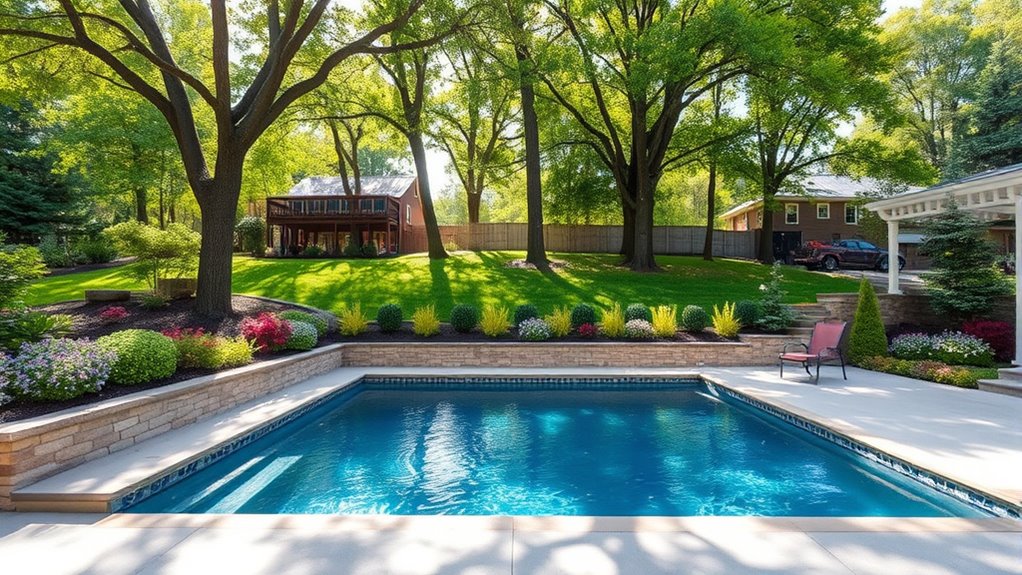
Proper maintenance is essential to keep your pool safe, functional, and enjoyable for years to come. Regular cleaning prevents algae buildup and keeps water clear. Monitoring chemical levels ensures your water remains balanced, reducing corrosion and skin irritation. Additionally, inspecting your pool’s structure and equipment prevents costly repairs down the line. Staying informed about projector technology can help you select the right equipment to enhance your pool area’s ambiance and entertainment options.
To effectively maintain your pool, consider these key aspects:
- Routine Cleaning and Chemical Testing: Schedule weekly skimming, vacuuming, and testing to maintain water quality.
- Structural Inspections: Check for cracks, leaks, or shifting, especially on sloped lots prone to movement.
- Equipment Upkeep: Regularly service pumps, filters, and heaters to ensure ideal performance and longevity.
Staying proactive helps you enjoy your pool safely and minimizes long-term maintenance costs.
Frequently Asked Questions
What Are the Cost Implications of Building a Pool on Challenging Terrain?
Building a pool on challenging terrain can substantially increase your costs. You’ll likely need extra excavation, specialized equipment, and reinforced structures to handle slopes or high water tables. These additional requirements mean higher labor and material expenses. Planning carefully and working with experienced contractors can help manage costs, but expect to spend more than on a flat, stable lot. Budget accordingly to ensure your project stays feasible and safe.
How Long Does the Construction Process Typically Take in Such Conditions?
You can expect the construction to take around 8 to 12 weeks, depending on terrain challenges. Imagine heavy machinery carving into a hillside, soil shifting beneath your feet, and workers carefully maneuvering the uneven landscape. Unique obstacles like high water tables might add extra steps, like soil stabilization or drainage solutions, extending the timeline. While more complex, with patience and professional expertise, you’ll soon enjoy your custom pool nestled into your challenging lot.
Are There Specific Types of Pools That Perform Better on Sloped Lots?
You should consider a retaining wall or a stepped pool design on sloped lots, as these options adapt well to uneven terrain. In-ground concrete pools offer durability and stability, making them ideal for sloped land, while vinyl or fiberglass pools can be customized to fit contouring needs. Consulting with a professional guarantees the pool type suits your lot’s specific slope and water table conditions, ensuring safety and longevity.
What Are the Insurance Considerations for Pools in High Water Table Areas?
If you build a pool in a high water table area, you should check your insurance policy for coverage gaps related to flooding or water damage. For example, a homeowner in Florida experienced frequent flooding and upgraded to flood insurance, adding coverage for pool leaks and seepage. You might also need to install special drainage or waterproofing systems to reduce risks, which can lower insurance premiums and provide peace of mind.
Can Existing Pools Be Retrofitted to Accommodate Land Slope or Water Table Issues?
Yes, you can retrofit existing pools to address land slope or high water table issues. You might need to relevel the pool, reinforce the foundation, or install additional drainage systems. Consulting a professional guarantees proper modifications, preventing future problems like shifting or water intrusion. While retrofitting can be complex, it’s often a practical solution to adapt your pool to challenging terrain or groundwater conditions, extending its lifespan and maintaining safety.
Conclusion
Building a pool on sloped land or high water tables is like steering through a rugged landscape—you’ll face challenges, but with the right tools and guidance, you can carve out your oasis. Think of your efforts as planting seeds in tough soil; patience and expertise will help your dream pool blossom. With careful planning and professionals by your side, you’ll transform a formidable terrain into a shimmering retreat—proof that perseverance turns obstacles into opportunities.
